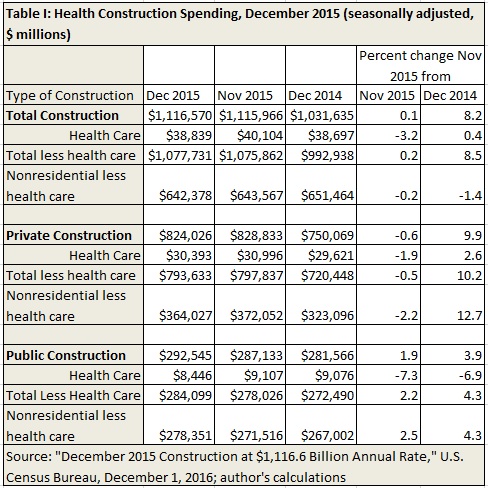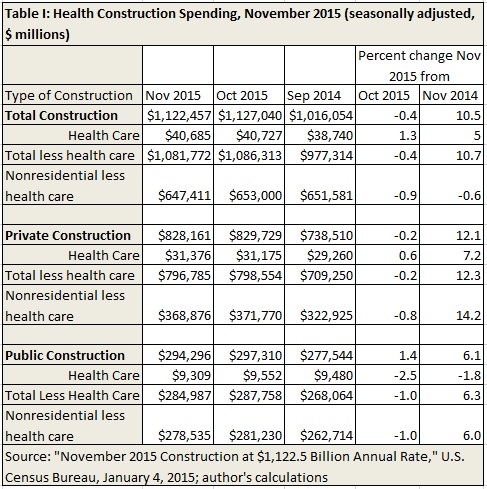Category: Hospitals
Health Facilities Exceed Other Construction in May
 April’s drop in health facilities starts looks to have been idiosyncratic. Health facilities exceeded other construction in May, as in March and February. While construction overall dropped at a seasonally adjusted annual rate of 0.8 percent, health construction increased 0.2 percent (See Table I below the fold).
April’s drop in health facilities starts looks to have been idiosyncratic. Health facilities exceeded other construction in May, as in March and February. While construction overall dropped at a seasonally adjusted annual rate of 0.8 percent, health construction increased 0.2 percent (See Table I below the fold).
The difference was especially apparent in private construction. Construction of private health facilities increased 0.5 percent, 0.8 percentage points more than other private construction, which declined. Construction of public health facilities dropped 1.0 percent, but this was less than half the drop in other public construction.
For the twelve months from May 2015, there is a significant difference in trend between private and public construction. Private construction increased 4.7 percent, and private health facilities starts increased at almost exactly the same rate. However, while public construction declined 2.6 percent, public construction of health facilities dropped only 1.4 percent.
Overall, health construction increased 3.3 percent, versus only 2.8 percent for non-health construction. Notwithstanding other factors, this indicates health costs will continue to increase faster than other sectors of the economy because (as the old saying goes) “a bed built is a bed filled.”
Is this the Insurance Casualty Model; Or Just a Dirty Trick?
The health insurance “Casualty Model” is alive and well in Georgia — but only as a punishment for not signing an in-network agreement or accepting usual and customary reimbursement for emergency room treatments. At issue is a Georgia hospital (and one in Los Angeles) that are not part of the Blue Cross and Blue Shield of Georgia network. Because neither of the hospitals are part of the insurer’s network, when covered individuals go to the hospitals’ emergency rooms, the insurer sends reimbursement checks for emergency care directly to enrollees. The enrollees are then supposed to endorse the checks over to the hospital. This is similar to the casualty model when an insurer provides funds for a covered claim and the covered individual shops around and receives a service at the provider of their choice. When someone slid into my car during an ice storm a few years ago, an adjuster came to my office and calculated an estimate. I received the check and was told I could get my car repaired almost anywhere for the estimated amount.
Health Construction Boomlet Collapses in April
 The boomlet in health construction from February and March lost its wind in April. While construction overall dropped at a seasonally adjusted annual rate of 1.8 percent, health construction dropped by 3.0 percent (See Table I below the fold).
The boomlet in health construction from February and March lost its wind in April. While construction overall dropped at a seasonally adjusted annual rate of 1.8 percent, health construction dropped by 3.0 percent (See Table I below the fold).
The drop was much greater for private than public health facilities, especially relative to other construction. Construction of private health facilities dropped 3.6 percent, 2.2 percentage points more than the decline in other private construction. Construction of public health facilities dropped 0.8 percent, 2.1 percentage points less than the decline in other public facilities.
This turnaround after a two-month boomlet puts health construction back on the longer term trend. For the twelve months from April 2015, construction of non-health facilities boomed 4.7 percent versus a decline of 0.6 percent for health facilities. Notwithstanding other factors, this is welcome because it indicates a shift from inpatient to outpatient care at lower cost.
Health Construction Boomlet Continues
 The boomlet in health construction, first noted in last month’s Census Bureau release, continued in March. Health facilities construction starts grew 1.6 percent, while other construction grew only 0.3 percent (Table I).
The boomlet in health construction, first noted in last month’s Census Bureau release, continued in March. Health facilities construction starts grew 1.6 percent, while other construction grew only 0.3 percent (Table I).
The rate of growth was significantly greater for public health facilities (2.3 percent) than private health facilities (1.4 percent). Further, the relative growth was much larger for public health facilities, because non-health public construction declined by 2 percent, while non-health private construction grew 0.7 percent.
This is the second month of uptick in health facilities construction. Over the last twelve months, health facilities construction starts have grown only half as fast as non-health starts (4.1 percent versus 8.2 percent). It is too early to say whether the boomlet in health facilities construction indicates a trending upturn. However, it suggests health systems are beginning to be optimistic about their abilities to continue to extract revenue from the system.
Boomlet in Health Construction In February
 Construction of new health facilities enjoyed a boomlet in February, growing 2.0 percent, while other construction shrank 0.6 percent (Table I).
Construction of new health facilities enjoyed a boomlet in February, growing 2.0 percent, while other construction shrank 0.6 percent (Table I).
The rate of growth in construction starts was similar for both private and public health facilities, at 2.0 percent and 1.7 percent. However, the relative growth was much larger for public health facilities, because non-health public construction declined much more than non-health private construction (a drop of 1.8 percent versus a drop of 0.2 percent).
This is the first uptick in health facilities construction in a while. Over the last twelve months, health facilities construction starts have lagged other construction starts by 7.2 percent (10.5 percent growth versus 3.3 percent growth). It is too early to say whether February’s boomlet in health facilities construction indicates a downturn. However, it suggests health systems are beginning to be optimistic about their abilities to continue to extract revenue from the system.
Two Thirds of Patients’ Hospital Debts Unpaid
 Holly Fletcher of The Tennessean has written a very informative feature on the hospital revenue cycle, including a seven-deck slideshow that translates the process into layman’s terms. (The Tennessean is the best daily newspaper for understanding hospitals, because Nashville is home to over for-profit hospital chains which control 60 percent of the beds in that industry, so the journalists know what they are talking about.)
Holly Fletcher of The Tennessean has written a very informative feature on the hospital revenue cycle, including a seven-deck slideshow that translates the process into layman’s terms. (The Tennessean is the best daily newspaper for understanding hospitals, because Nashville is home to over for-profit hospital chains which control 60 percent of the beds in that industry, so the journalists know what they are talking about.)
Ms. Fletcher describes an insane system of billing which has been focused on getting dollars out of the byzantine bureaucracies we call health insurers. The main economic reason insurance should be for rare, unforeseen, catastrophic events is that claims processing is expensive. It is not just shuffling paper around, but also managing fraud, waste and abuse. This adds to what is called the “load” of insurance.
When it comes to getting money from patients directly, hospitals are hopeless, with two thirds of their accounts receivable remaining unpaid: “Billing practices are not designed to collect small, incremental payments from hundreds or thousands of patients. They are designed to bill a handful of large entities — insurance companies — not individuals who walk in the door.”
One might think this was a problem that is not too difficult to solve: Just call the supermarket or department store and ask them to recommend a point-of-sale technology vendor.
Health Construction Still Very Weak in January
 Construction of new health facilities remained very weak in January, shrinking 0.1 percent since December, while other construction grew at 1.6 percent (Table I).
Construction of new health facilities remained very weak in January, shrinking 0.1 percent since December, while other construction grew at 1.6 percent (Table I).
The rate of decline in public health facilities continued to be dramatic at 5.0 percent, versus booming 4.8 percent growth in other public construction starts. Private health facilities construction grew 1.3 percent in slow private construction market, which grew just 0.5 percent.
Over the last twelve months, health facilities construction starts have lagged other construction significantly. This suggests health systems are pessimistic about their ability to extract further revenue from the system.
Health Construction Collapses in December
Construction of new health facilities collapsed in December, shrinking 3.2 percent since November, while other construction eked out growth of 0.2 percent (Table I).
Most of the decline occurred in public health facilities, for which construction starts shrank 7.3 percent, versus 2.2 percent growth in other public construction starts. Private health facilities construction shrank 1.9 percent in a shrinking private construction market.
Over the last twelve months, health facilities construction starts have lagged other construction significantly. This suggests health systems are pessimistic about their ability to extract further revenue from the system.




